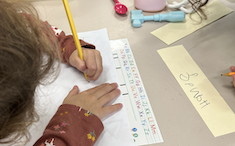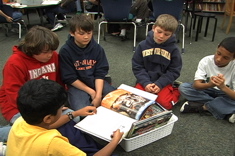When I first started teaching (and for more years than I’d like to admit), this is what it sounded like when it was time for independent writing time to begin:
Me
“Ooooh, I loooove how Anais is getting to work!”
“Let me get you a pen so you can get started.”
“Maybe you can write about…”
Kids
“I don’t know what to write about!”
“How do you spell…?”
“What’s the date today?”
Doesn’t sound so bad—maybe it even feels familiar. But here’s the thing: At the end of the day my colleagues and I would grouse about how challenging it was for kids to work independently. “I have to do everything for them!” was our common refrain.
It took some time, reading, and coaching to realize that all the things I was saying and doing in those first few minutes of writing time were leading to my students’ dependence on me!
Here are some lessons I’ve learned that changed my actions during those first few moments of writing time, as well as during and at the end, that increased my students’ agency and independence as writers (and learners).
Before Writing Time
Failing to plan is planning to fail.
Before having a literacy coach, this was the scenario I’d often find myself in: I would finish teaching a minilesson and give kids the menu of options for their work time. I’d send them off, expecting writers to get started all on their own, like magic. Instead, I’d hear those phrases I listed at the beginning, or even worse, “What are we supposed to do?” Nooooooooo, I just told you. I gave you your options. How can you be asking this?
Instead of being destined to a lifetime of answering questions I had just answered, I implemented two tweaks from my coach to help kids be more successful at getting started. The first one was to do a quick check-in when I was naming the kind of work that kids might be doing that day. Instead of just saying, “Some of you might be revising, using all the techniques we’ve learned so far; some of you might be finishing up your draft,” etc., I turned it into a question: “Who thinks they’ll be revising today? Give me a thumbs-up. Who’s going to be finishing up their draft?” That small change allowed kids to set their intention before leaving the gathering area.
Another shift I made was to give kids a chance to make a work plan. They might just turn and tell their writing partner the first thing they’re going to work on when they get started. Or they can make themselves a to-do list in their writing notebook (and then share that with a partner). The version you choose might depend on your grade level and where kids are in the writing process.
Silence is golden.
Let’s take that line from the beginning of this article. I always joke that I’d be retired in the Bahamas if I had a nickel for every time I said, “I love how So-and-So is…” or “I really like the way So-and-So is…” I’ll never be retired in the Bahamas since no one will give me a nickel and because I almost never use those phrases in the classroom anymore. In calling out these praise phrases, I was undermining students’ independence by getting them accustomed to hearing my voice before getting to work. Rather than being able to initiate their work time on their own, they were waiting to hear instructions to get started… again, or they were waiting to have their actions validated. Doling out directions or shout-outs while kids were getting started also disrupted students’ ability to have quiet think time needed to get writing.
Although it was a challenge at first, it’s become a new habit to be silent when kids are just getting started during their independent time. Instead of micromanaging writers, I use that time to observe their writerly behaviors and their problem-solving skills. If kids do need a little nudge or reminder, I use silent gestures to point to a chart or remind them to focus on their writing paper or notebook. Now kids have an opportunity to practice their independence and solve problems on their own, all while I’ve set the tone for a quieter, more thoughtful writing time.
During Writing Time
Words matter.
Did you catch that earlier? I don’t use the phrases “I love how…” or “I like the way…” or variations on that theme anymore, or at least I very rarely use them. But it’s not just because I was making a lot of noise and disrupting my students’ independent time; I was also inadvertently diminishing their agency. How many times do students come to us and ask, “Is this good?”
My go-to answer was almost always, “What do you think?”
Oftentimes the answers ranged from “Yeah, I think it is,” to “I don’t know.” (That’s why I’m asking you. Duh.) By constantly telling students I liked or loved the things they were doing, I was training them to come to me for validation. When addressing those sentence stems, Peter Johnston says in Opening Minds, “Rather than offering an agentive narrative, it offers a judgment and implies that the point of the child’s efforts is to please you.”
To send kids the message that they have agency during writing, I focus my feedback on the process, rather than the writer. To really give it more power, I also name something specific and add why it’s important or what effect it has on the reader. So instead of saying, “You’re such a good writer!,” I might say, “The way you added dialogue to this scene really made your characters come to life.” Stopping right there already tells the writer that something they did produced an effect on someone else, and ideally, they’ll keep doing that thing.
But wait, there’s more! When my conferring game is really strong, I can also build on the feedback to offer a new strategy or tip. Continuing my feedback might sound like, “Something else writers do to develop their characters is add details about what the character looks like. Is that something you could try in your piece?” By delivering feedback in this way, I can reinforce an agentive narrative: Here is a strategy to try that is built on something you’re already doing, and you make the decision about how you can apply it. More agency. More independence.
After Writing
Two heads are better than one.
“Oh no, it’s lunchtime! We’ll clean up our writing when we get back.” That used to be the extent of my “wrap-up” at the end of writing workshop. By not reserving five to 10 minutes at the end of our independent writing time, I was robbing myself of opportunities to teach even more. Once I started consistently setting the timer, I was able to use that time to not only tuck in some editing work or another writing strategy but build agency and independence. When too many writers were asking, “How do you spell…?” or saying, “I can’t find my pen,” I used those closing minutes to crowdsource solutions to these common problems. Here’s an example of what that sounds like:
“Writers, many of you were raising your hand to ask, ‘How do you spell..?’ or you were asking your neighbors to spell words for you. This was getting in the way of all of us doing our best work. You all know some different strategies for figuring out tricky words. Turn and talk to your partner about some of the ways we can spell words for ourselves.” [Partners talk to each other. Teacher listens in on the conversations.]
“You all know so many different strategies to spell unfamiliar words! I’m going to chart all of your ideas here. Now when you don’t know how to spell something, you can use this chart to remind yourself of some strategies you can try. Turn and tell your partner which strategy you might try the next time you get stuck spelling a tricky word.”
This same closing structure can be used for other times kids get stuck, like not knowing where to get materials or what to do when they think they’re finished. Again, having kids think through the solutions to their problems together gives them a greater sense of agency. Because they’ve come up with the ideas themselves, they may also be more ready to use them independently when it comes time.
If you walk into a writing workshop that I’m leading today, the first few moments before independent writing time usually sounds like this:






